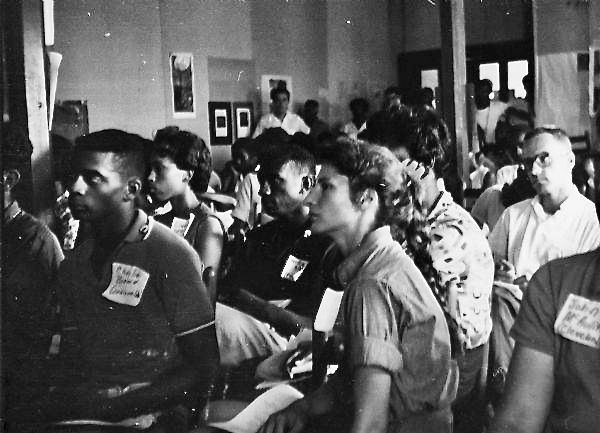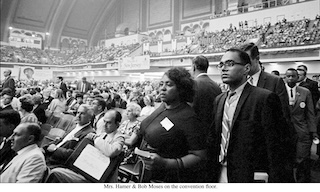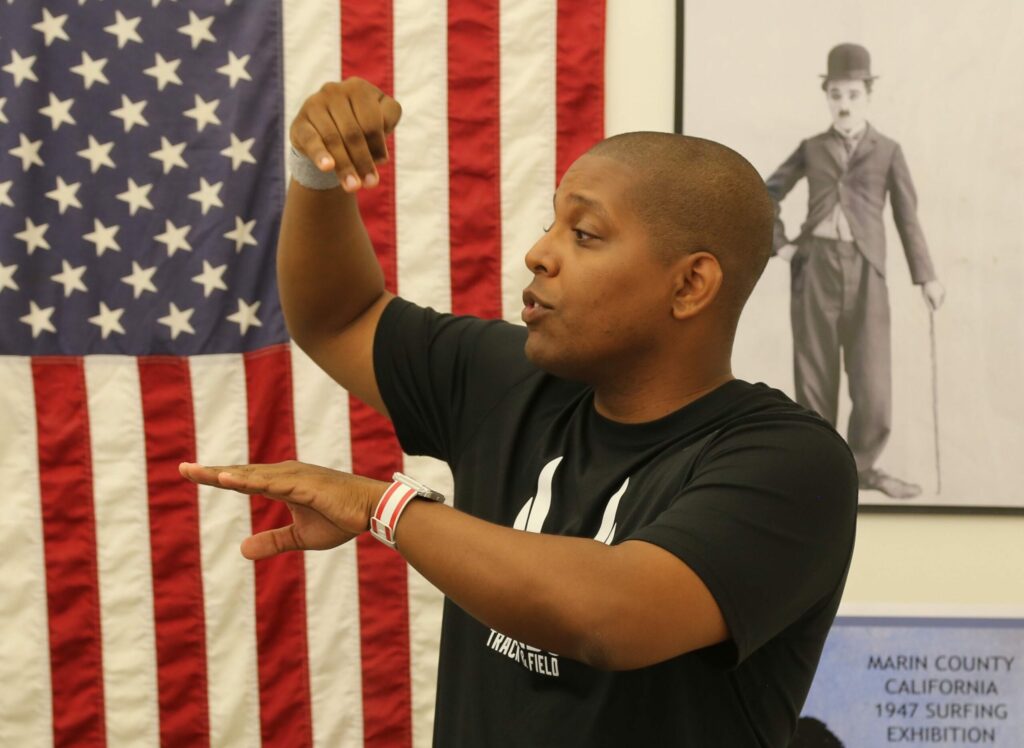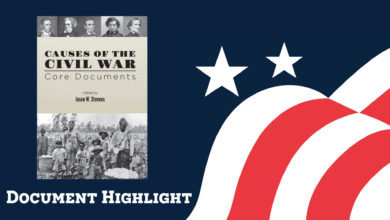
This summer marks the sixtieth anniversary of a watershed season of civil rights organizing across the state of Mississippi. Referenced internally as the 1964 Mississippi Summer Project and advertised as the Mississippi Freedom Project, this period has since been memorialized as Freedom Summer. The effort sought to democratize the state that Roy Wilkins, executive director of the NAACP, called “the most savage uncivilized state in the entire fifty states.” A turning point in civil rights strategy, Freedom Summer operated at a greater scale of magnitude and complexity than previous efforts. In a summer of activism bookended by tragedy at its beginning and a political showdown 1000 miles away from Mississippi at its close, Freedom Summer cemented the fight for civil rights and the power of student movements in stoking institutional change.
While the work of civil rights activism was urgent throughout the Jim Crow South, Freedom Summer organizers recognized the Mississippi of 1964 as a distinctly heated place and time. Mississippi was the site of the most notorious lynching in the early civil rights movement, the killing of Emmett Till in 1955, and had the highest rates of lynching in the country — violence meant to impose social, economic, and political intimidation. Add to this violence the pervasive harassment of black residents, along with numerous formal acts of repression, and it is clear why activists deemed Mississippi a crucial, yet perilous, site for resistance. As organizer Curtis Hayes put it, “If we were going to fight for freedom, Mississippi was the test. You had to break Mississippi.”
The potential and peril of activism in Mississippi had been evident in the years leading up to 1964. Young Mississippians, organized and recruited by the Congress of Racial Equality (CORE) and the Student Nonviolent Coordinating Committee (SNCC), participated in the Sit-in Movement. Concurrently, civil rights activists in Mississippi participated in a series of “Wade-Ins” to integrate public beaches, “Read-Ins” to desegregate public libraries, and “Pray-Ins” at all-white churches. This ascendant energy, largely driven by students at historically black colleges like Tougaloo in Jackson, increased regional coverage of the movement and boosted momentum. And yet for many activists, the attention and momentum had not yet built to a level they felt suited the scale and urgency of the Mississippi challenge.
Then came the assassination of Medgar Evers, Field Secretary of the Mississippi NAACP, in June 1963 — the most high-profile murder of a civil rights activist to that date. This act, combined with murders of organizers who sought to register black Mississipians to vote, fortified activists’ resolve to democratize the state during the following summer.

Mississippi organizers knew that a project worthy of their ambitions would require a novel approach and greater scale of organizing than they had yet employed. In 1961, the Mississippi chapters of the NAACP, SNCC, and CORE (in conjunction with other local groups) had begun coordinating voter outreach and registration efforts through an umbrella coalition, the Council of Federated Organizations (COFO). This alliance would be crucial to coordinating the 1964 Summer Project, resourcing institutional memory and best practices while also tapping into an established and committed grassroots network that operated out of churches, storefronts, community centers, and private homes throughout Mississippi’s black communities.
COFO organized intricate transportation and communication networks and recruited dedicated activists. Organizations beyond Mississippi, such as the Northern Student Movement, responded, leading the national recruitment of college students for the Summer Project. They also collaborated with the National Council of Churches (NCC) to coordinate training for these volunteers. The young volunteers were joined in Mississippi by over 250 NCC-sponsored clergy, along with hundreds of legal and healthcare professionals. Myriad organizations were aligned, focused, and mobilized to support COFO’s goals.
The most controversial strategy of the Summer Project was COFO’s decision to invite white students to participate. Critics both worried about the blowback from endangering white students and feared the repercussions of potentially reckless and ignorant white volunteers visiting Mississippi on what might amount to a glorified “service project” for them. Ultimately, the perspective of Bob Moses — a Harvard-educated math teacher and organizer from Harlem (and the man most identified with Freedom Summer’s field operation) won out. As Moses maintained, “These students bring the rest of the country with them. They’re from good schools and their parents are influential. The interest of the country is awakened and … the government responds.” Moses knew that activist efforts and the subsequent assaults that followed often struggled for recognition beyond the black press, and would gain a greater spotlight through interracial allyship. However, both critics and supporters of the invitation insisted that the Summer Project weed out applicants with any hint of ulterior or cynical agendas, and that field secretaries communicate to white volunteers, in no uncertain terms, the stakes of the Summer Project’s work.
Close experience of Mississippi’s struggles made the stakes of the Summer Project tragically, vividly, and starkly clear. Just one day after the first wave of white volunteers arrived to assist in voter mobilization, three volunteers already working on the ground — black Mississippian James Chaney and white New Yorkers Andrew Goodman and Michael Schwerner — went missing. COFO immediately contacted federal law enforcement and the national media to demand and publicize a manhunt. Movement pressure forced the FBI to open an office in Jackson that summer, and compelled Mississippi governor Paul B. Johnson to cooperate in the search as well. In the course of the investigation, and before discovering the bodies of the three civil rights workers six weeks later, law enforcement discovered eight more murdered young black men, whose disappearances had not been investigated. (Many of these victims still have not been identified decades later.) Now no one could deny the peril of their summer mission. But the revelations strengthened the overwhelming majority of volunteers in their sense of purpose. Intentions matured into resolve.
While the Summer Project contained numerous facets, they were all united by the motif of freedom. In the Fall of 1963, black Mississippians had begun to refer to their political participation as “Freedom Votes” and by early 1964 were drawing local media attention to “Freedom Days” of voter registration. Summer Project workers lived and worked in rented or donated spaces that became known as “Freedom Houses.” Volunteers who came to Mississippi after the initial June wave often assisted the ongoing civic and practical education taking place in “Freedom Schools.” Permeating all of this work, in all of these spaces and beyond, were the “Freedom Songs” of joy, solidarity, and determination — expressions of collective purpose that acted as their own form of resistance.

The best known of these “freedom facets” is also the most immediately politically consequential one: the Mississippi Freedom Democratic Party (MFDP). Just as other parts of the Summer Project fought to democratize the citizenry, the MFDP fought to democratize the state’s dominant political institutions. While black voters in Great Migration cities had gravitated toward the Democratic Party during the New Deal, in the South the party had long been a bastion of unreconstructed Southerners and Jim Crow enforcers, with no black representation whatsoever in Mississippi. The Freedom Democrats mirrored the procedures of the state’s official Democratic Party as closely as possible — from paperwork, to precinct meetings, to delegation selection — with the crucial modification of making each of these processes open and inclusive, the goal being to seat a more representative delegation as the official Mississippi Democratic Party at the Democratic National Convention (DNC) that August.
Continuing to adhere scrupulously to party procedures, the MFDP arrived in Atlantic City intending to persuade the convention’s credentials committee that, as the only Mississippi delegates selected through an open and transparent process, they were the rightful representatives of the state’s best interests. They entered the convention with public sympathy on their side; the bodies of Chaney, Schwerner, and Goodman (murdered at the beginning of the Summer Project) were discovered two days before the convention’s start, refocusing national attention on the cause. And with the MFDP’s chosen lead petitioner to the credentials committee, Fannie Lou Hamer, they found a forceful appeal to hearts and minds. The most famous figure to rise to national attention during Freedom Summer, Hamer had been repeatedly terrorized and arrested for her activity in voter mobilization efforts. In her speech at the DNC on August 22, she detailed abuses she and other activists had suffered before closing with a pointed challenge to the committee:
… if the Freedom Democratic Party is not seated now, I question America. Is this America, the land of the free and the home of the brave, where we have to sleep with our telephones off the hooks because our lives be threatened daily, because we want to live as decent human beings, in America?
Hamer’s speech further swayed public sympathy for the MFDP. While President Lyndon Johnson had been making significant steps in recognizing civil rights, including signing the CIvil Rights Act earlier in the summer, he feared the electoral consequences of supporting the MFDP. At his insistence, the DNC delayed a recognition vote (to cool the emotions Hamer aroused), then offered a compromise: the DNC would recognize two MFDP delegates (one black member, one white member) in a ceremonial capacity and promise larger structural change and greater inclusion at future conventions. The compromise satisfied neither the MFDP (who rejected it and continued to protest) nor the all-white official state party (all but a handful leaving in outrage). Johnson’s political maneuvering on this front proved for naught: while he defeated Republican candidate Barry Goldwater in a landslide in the November general election, he ultimately lost Mississippi and four other Deep South states.
Many of the most impactful feats of activism demonstrate powerful combinations of protest and partnership, resistance and coordination. Freedom Summer shows how such cooperation bears fruit. The project drew on a vast network of interpersonal and organizational partnerships, involving a cast of thousands. The creativity, discipline, and courage of the participants galvanized future efforts in the civil rights and student movements. While Freedom Summer’s voter registration efforts ultimately fell short of organizational ambitions, it inspired future mobilization efforts in Mississippi and beyond. It fed the momentum for the Voting Rights Act of 1965. Finally, its institutional challenge at the DNC precipitated changes in both the delegation practices and in the very composition of the Democratic Party.
ADDITIONAL WORKS CONSULTED
Biewen, John, host/producer. “Freedom Summer.” Scene On Radio. Season 4, Episode 7. Center for Documentary Studies, Duke University. April 2020. Podcast.
Dittmer, John. Local People: the Struggle for Civil Rights in Mississippi. University of Illinois Press, 1995
“Freedom Summer, 1964.” History this Week. The History Channel. June 2020. Podcast.
“I Question America: 1963-1964.” Mississippi Civil Rights Museum. Jackson, MS. Visited on-site June 2024.
SNCC & Grassroots Organizing: Interpretive Booklet. SNCC Legacy Project. 2024.

Malik Ali, a James Madison Fellow and 2017 graduate of the Master of Arts in American History and Government program, is Tukman Distinguished Teacher of History at the Branson School in Ross, California.






